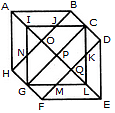MCQ: Analysis (Analytical Reasoning) - 1 - SSC CGL MCQ
15 Questions MCQ Test General Intelligence and Reasoning for SSC CGL - MCQ: Analysis (Analytical Reasoning) - 1
Find the number of triangles in the given figure.


Find the number of triangles in the given figure.


| 1 Crore+ students have signed up on EduRev. Have you? Download the App |
Find the number of triangles in the given figure.


Find the number of triangles in the given figure.

Find the number of triangles in the given figure.

Find the number of triangles in the given figure.

Find the number of triangles in the given figure.

Find the minimum number of straight lines required to make the given figure.

Find the minimum number of straight lines required to make the given figure.

Find the number of triangles in the given figure.

Find the number of triangles in the given figure.

Find the minimum number of straight lines required to make the given figure.

Find the number of triangles in the given figure.

Find the number of triangles in the given figure.

Find the number of triangles in the given figure.

|
177 videos|126 docs|197 tests
|
|
177 videos|126 docs|197 tests
|
































